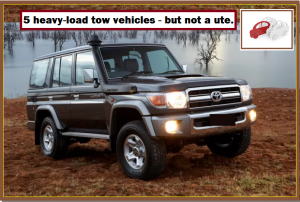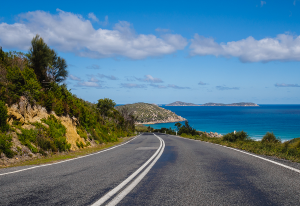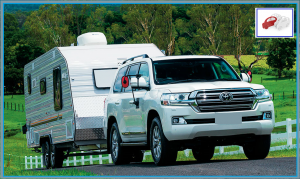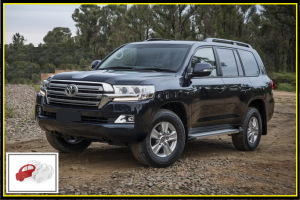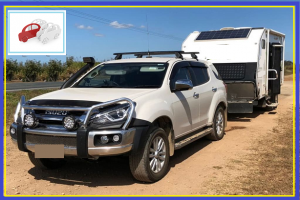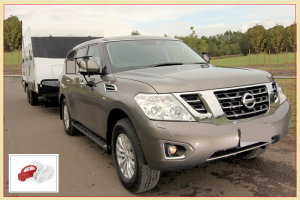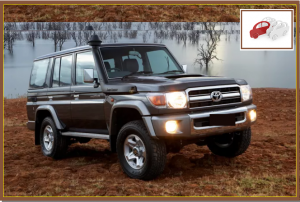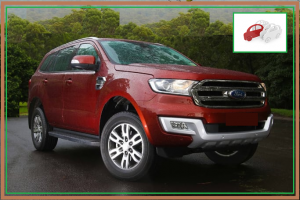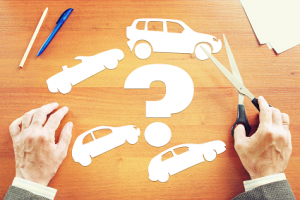DABAS blog post: Mid-January 2019
FYI – Five heavy-load towing vehicles “without a tray”
Hello readers: So, you would like to tow something heavy? like a horse float or large caravan? but you need more seats? (and don’t want a dual-cab ute, or the enormous Dodge Ram). Well, the last decade’s rise in popularity of the SUV is well documented, and it’s due in no small part to how adept modern 4WDs are at fitting a growing family, or grey nomads’ luggage in whilst towing boats, camper trailers, caravans or horse floats. But if you are buying a large SUV, 2WD or 4WD, with a view to using it as a heavy-tow vehicle, it does need to have certain capabilities to avoid vehicle damage and to help everyone arrive at their destination safely. With that in mind, in this blog post, let’s look at five good capable (horse-float?) towing vehicles that may suit your needs. We hope you find it an interesting read, whilst shining some light on information that may assist you selecting a suitable vehicle for your towing needs, providing some useful “very general-in-nature” information to help you on your vehicle selection and vehicle-buying journey; more detailed information on the featured vehicles will be provided upon your transition to becoming a DABAS client.
Psst – before we start, let’s go over these 3 things (below) again: also see the past DABAS blog post on towing.
Maximum braked towing limit: All vehicle manufacturers dictate a maximum unbraked towing limit (the most a trailer, without some form of braking system, can weigh) and a maximum braked towing capacity, which is the most a vehicle can tow, assuming the trailer is fitted with its own brakes. Note: This is worth taking into serious consideration when choosing a suitable-to-your-needs tow vehicle, because it could limit the variety and size of caravans or trailers you are able to tow. For example, it has been reported that pre-MY2018 model Toyota Landcruiser Prado can tow a maximum of 2500kg (MY19 models are now 3000kg), so any caravan that weighs more than this while it’s being towed is out of the Prado’s reach. And that’s only if the trailer has brakes – if not, the Prado is limited to towing a maximum of 750kg.
Maximum tow-ball download: This is the weight a caravan’s tow hitch puts on the vehicle’s tow bar. It is set by the vehicle manufacturer and the driver must adhere to it. Like the towing limit, this can vary between make and model, and engine and transmission combinations. And tow-ball download can have serious effects on vehicle performance. However, while many SUVs allow a tow-ball download that’s 10 per cent of the vehicle’s maximum towing limit, not all do. One reported example is the Kia Sorento, which can tow a respectable 2500kg, but can only have 150kg of tow-ball download.
Gross Combination Mass vs. Payload: These two limits are relatively simple to work out. A little harder is the effective towing limit of your intended 4WD or SUV once it has the people, accessories and luggage you’ll load into it. All vehicles have a gross combination mass (GCM), which is the maximum it and any trailer can weigh in combination. For example, it is reported that the Mitsubishi Pajero Sport Exceed has a gross combination mass of 5400kg. On its own, it weighs 2105kg and it can tow up to 3100kg with 300kg on the ball. But in doing so, the combined weight is now 2105kg plus 3100kg of caravan: that’s 5205kg even before the driver, passengers, luggage, and accessories such as side steps and a bull bar are on board. Considering the Pajero Sport has a payload capacity of 605kg, any caravan or trailer weighing more than 2500kg would overload the vehicle if it already had a full load. When towing 3100kg, there’s not much room for more than a driver and a “skinny triathlete passenger”. At best, this is going to strain the vehicle beyond manufacturer’s recommendations and, at worst, result in insurance claim rejection if you have an accident. So, with that in mind, here’s a choice of five full-size SUV wagons that may suit your needs (not in any order), with credentials that are highly desirable for horse float or caravan towing, to help make your next towing adventure to Flemington or Fremantle as stress-free as possible.
These choices of large SUVs usually offer the flexibility of a third row of seats if desired, so that the vehicle can carry up to seven (some in this list do seat eight occupants) or the third row can be folded away when more luggage space is required. Passenger comfort in the second row of seats is also increased in a wagon, as at times the seat base can be slid rearward to provide more leg room and the backrest angle can also be adjusted as required. A large SUV wagon’s rear-luggage area also provides ample storage space that is lockable and weather-sealed. Full-size SUV 4×4 wagons are also equipped with coil-spring rear suspension that offers a more comfortable ride than the leaf springs found in most utes yet offers similar peak tow ratings. They also tend to have short rear overhangs, which result in a short distance between the rear axle centreline and the tow-ball. This is an important dimension, because the shorter this distance, the less potential ‘yaw’ (side to side) movement between vehicle and load; therefore, greater towing stability. A large SUV wagon also shines when it’s time to unhook your load and do some exploring of your travel destination.
If you would like DABAS’s assistance buying a tow vehicle, please click here.
Here we go,
The Toyota Land-Cruiser 200 Series GXL
If you were given a blank piece of paper on which to design the ideal towing vehicle, you’d probably end up with something close to this popular tow vehicle. Its hefty 2630kg kerb weight and 2850mm wheelbase provide a cruise-ship-grade anchor, with smooth-riding coil-spring suspension and a short rear axle to tow-ball reach. The 4.5 litre twin-turbocharged diesel V8 has enough torque (650Nm) to pull a house off its stumps, matched with an intelligent and smooth-shifting six-speed auto. The massive 6850kg GCM also means you don’t have to reduce its 3300kg GVM (that’s a payload of almost 670kg) even when towing the maximum 3500kg. It can work up a thirst for fuel when heavy hauling but the 200 is still widely considered to be the heavy-load towing benchmark. The Land-Cruiser 200 remains the go-to heavy hauler for those who can afford to stump up the cash for it. Reportedly the Land-Cruiser’s ability to feel tethered to the road almost regardless of what it’s towing is very good. The reasons for this are simple: it’s heavy, has a long wheelbase and its rear axle-to-coupling measurement is relatively short. Strong performance and comfort when towing are other good points in its favour. It is worth noting some comments that the 200 Series is getting on (it launched in 2006 and was last refreshed in 2016) and the 4.5-litre V8 twin-turbo diesel engine is reportedly nearly as thirsty as the petrol model when towing.
Price: From – $88,300* (plus on-road costs) – *for up-to-the-minute pricing see the Toyota Australia website – Power/torque: 195kW/650Nm – Kerb weight: 2610kg – Towing capacity: 350kg/3500kg – Gross Combined Mass: 6800kg – Fuel consumption (towing): 19.2L/100km – Touring range (towing, with 50km safety margin) 669km.
The Isuzu MU-X LS-T
The MU-X is said by some reports to be old-school now, and yet it continues to be reviewed as one of the best tow wagons on the market. Its specification sheet is dated, but once you hitch up a heavy trailer you discover it was built to tow. It is said to feel planted on the road, engine braking is very good, performance up a hill is better than the torque and power figures would suggest, and the MU-X is reportedly light on fuel when towing. The Isuzu MU-X is said to be among the best of the ute-based-platform SUVs out there; its 2845mm wheelbase and 2075kg kerb weight provide a stable and predictable towing platform. The refined 3.0 litre four-cylinder turbo-diesel matched with its six-speed auto provides strong yet economic performance under sustained loads. And with a generous 5750kg GCM it’s rated to tow up to 3000kg of braked trailer without having to reduce its peak 675kg payload. Pssst – keep in mind that for many years Isuzu utes (re-badged) formed the popular Holden Rodeo range, and there is also a long history of truck building behind this Japanese brand, shining through in the load-hauling capabilities of the MU-X.
Price: From – *$53,500 (plus on-road costs) – *for up-to-the-minute pricing see Isuzu’s Australian website – Power/torque: 130kW/380Nm – Kerb weight: 2060kg – Towing capacity: 300kg/3000kg –Gross Combined Mass: 5750kg – Fuel consumption (towing) 12.9L/100km – Touring range (towing, with 50km safety margin) 454km.
The Nissan Patrol Ti-L
This big Nissan Patrol can get a heavy-towing job done with much the same stability as a 200 Series and at not-much-more fuel cost than a Land-Cruiser diesel 200. The Nissan Patrol reportedly will easily eat up kilometres of hill towing with a heavy van attached. The specs look good: The Patrol has a solid kerb weight (2715kg) and a relatively long wheelbase/short rear axle to tow-ball measurement. While the Patrol’s 21L/100km towing average consumption might seem high to some, as mentioned earlier the Land-Cruiser 200 diesel develops a similar thirst when lugging a 3000kg trailer around. The only downside for the Patrol is the tow-ball download – you must reduce payload by 130kg to maintain a 350kg TBM. That still gives you a 620kg payload, which isn’t too bad when you consider how hobbled some of the dual-cab utes are.
Price: From – *$88,990 (plus on-road costs) – *for up-to-the-minute pricing see Nissan’s Australian website – Power/torque: 298kW/560Nm – Kerb weight: 2715kg – Towing capacity: 350kg/3500kg – Gross Combined Mass: 7000kg – Fuel consumption (towing) 20.8L/100km – Touring range (towing, with 50km safety margin) 623km.
76 series GXL Toyota
The mighty 70 Series has earned its great reputation, with many decades of reliable service in some of the toughest work and play environments on earth. Its rigid live axles (unmatched for ruggedness and load-carrying ability) and five-speed manual gearbox are defiantly a bit old school, but that’s the way its loyal fan-base of customers want it (although some say an auto option for towing would be good). The 4.5-litre single-turbo diesel V8 handles hard work, with 430Nm available across a 2000rpm torque band as wide as Port Phillip bay. A 2730mm wheelbase and 2265kg kerb weight provide a solid anchor for caravan towing and with a huge 6560kg GCM, it’s rated to carry its maximum payload (795kg) while towing the maximum 3500kg.
Price: From *$72,332 (Driveaway) – *for up-to-the-minute pricing see Toyota’s Australian website – Power/torque: 151kw/430Nm – Kerb weight: 2265kg – Towing capacity: 350kg/3500kg – Gross Combined Mass: 6560kg – Fuel consumption: factory normal spec is 10.7 litres per 100kms (reported 15.0L/100 when towing) – Touring range: 130Litre fuel tank.
Ford Everest
The towing ability of the Ford Ranger dual-cab ute (and its Mazda BT50 birth twin) is well documented. Fortunately, the multi award-winning Everest wagon, which is derived from the Ranger, shares much of the ute’s DNA with the bonus for families of seven seats. The five-cylinder 3.2Lt turbo-diesel with 470Nm and smooth-shifting six-speed automatic is matched with permanent all-wheel drive. (*MY19 Trend Bi-turbo 2LT is@157Kws/500Nm /My19 Trends-10 speed transmission). The Everest’s shorter 2850mm wheelbase and solid 2407kg kerb weight, combined with coil-spring rear suspension, short rear axle to tow-ball reach and 3000kg braked towing capacity, add up to a very capable tow vehicle. A note to keep in mind though is that to tow 3000kg and not exceed the Everest’s 5800kg GCM, the peak 693kg payload must be reduced by 300kg. The significantly lower-priced RWD version shares the same 3000kg braked tow rating and could be ideal for caravaners who never venture far from the bitumen.
Price: Everest Trend RWD *$55,190 (Driveaway) & The Everest Titanium 4WD is $72,990 (Driveaway) – *for up-to-the-minute pricing see Ford’s Australian website – Power/torque:MY18 3.2L D @143KW/470Nm (MY19 Bi-Turbo 2lt D is @157Kw/ 500Nm) – Kerb weight: 2407kg – Towing capacity: 300kg/3000kg – Gross Combined Mass: 5800kg – Fuel consumption: 8.5L/100km or 2lt Bi-Turbo D @ 6.9L/100kms (non-towing) – Touring range: 80 Litre fuel-tank.
A free DABAS towing tip: Other large-load tow-vehicle features to look for are a reversing camera with guidelines, which make lining up your vehicle’s tow-ball with your caravan’s tow hitch as easy and fun as joining the dots. Also look for trailer sway control in a tow vehicle’s stability control menu as It can help avoid a lot of stressful sweaty-palm situations. Other considerations? Of course, there are many more vehicles and other important factors to think of when selecting a suitable tow vehicle: they include fuel economy, power and torque, safety, refinement, towing-speed limitations, and your own personal preferences such as intended usage, ground clearance, ute, SUV wagon, 5 – or 7-seater, comfort, safety technology , servicing and repair costs, warranty coverage and the vehicle’s re-sale value. So carefully consider its intended usage and how much your selected vehicle will need to tow, what the load on the tow ball will be, and how your caravan or horse float will affect payload; thinking of all this can help you buy a suitable vehicle for your towing needs.- Whichever one you end up choosing, DABAS can help do your research, arrange an inspection, check the vehicle’s history, take it on a test drive with you, and help you deal with your paperwork at the LMCT car-yard.
At DABAS we know that buying a car to suit your needs can be one of the biggest purchases in your life; we hope this intended to be “general-in-nature advice and information” blog page has provided some helpful assistance for you in deciding the path of your tow-vehicle-buying journey. Please note: examples, options, pricing and information mentioned in this blog post are to be considered as a very general-in-nature summary; all specifications, information and advice mentioned in this blog page may be outdated or superseded by the time of your reading of this blog page; all information will confirmed at the time of you updating into your next vehicle, along with your chosen vehicle’s sales representative in their LMCT showroom at the time you transition to becoming a client of DABAS.
We look forward to having a chat
When the need arises for you to update your car; to assess your personal car-safety requirements and buying needs to suit your lifestyle.
And importantly your set specified budget!
Whatever roads your life journey takes you on, DABAS can help you find a car to travel those roads.
When it comes time to update your car DABAS is aware of some *things to consider within these featured model ranges, plus more of the opposition comparisons, things to keep in mind – including when you are trading in your old car at a LMCT used-car yard – and the special trade-in incentives offered on drive-away-no-more-to-pay deals obtainable – at times – within leading brands’ Melbourne LMCT used car dealerships. *These will be discussed upon your transition to becoming a client of DABAS.
To contact DABAS to discuss your car-buying needs, please click here
To see a self-evaluating check list – is it time to update your car – please click here
To see some interesting things to consider when buying a car, please click here
To see 3 things to consider when moving on from your old car, please click here
For a step-by-step example of a DABAS car-buying journey, please click here
For an interesting DABAS blog on tyre safety please click here.
For some information on towing terminology and guidelines, please click here
For DABAS past blog topics: see our archived index, please click here
Thanks for visiting DABAS’s website and blog: Have a great day, Cheers, Tim.
Please note: All information mentioned in this blog post is to be considered as a very general-in-nature summary; information mentioned in this blog page may be outdated or superseded by the time you read it.

